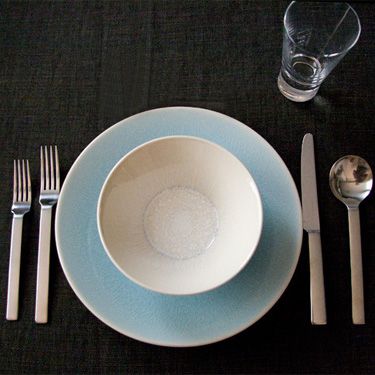
Now that we're all spending a lot more time at home, here's a helpful task to add to the spring cleaning list: making your space more dementia friendly. Don't worry, "Designing for Dementia" makes it sound a lot more complicated than it really is!
Using a few design best practices, you'll find there are a number of small changes you can make at home that will have a big impact on the quality of life for both you and your loved one. People with dementia face particular visual deficits, including difficulty with color discrimination, depth perception, and sensitivity to contrast. With this in mind, adapting a few little things can lead to a very positive change at home.
Contrast is Key
If you remember anything about designing for dementia, remember this: contrast is key! This principle will apply to many areas of the home; using a color that contrasts with its background will draw attention to the feature. So, for example, furniture should be a contrasting color from the wall behind it, so that your loved one can easily find it. If you’re not in the market for new furniture, consider a brightly colored slipcover or even put a throw blanket on the back of their favorite chair to draw attention. In the bathroom, consider painting the wall behind the toilet a color, as a light-colored toilet can easily blend in with a light colored wall. An even easier fix? Put on a new toilet seat in a contrasting color to draw attention to the most important feature! Color and contrast can be used to highlight any needed areas in the home. If your loved one is having trouble locating the bathroom, paint the door a bright color. If they’re having trouble at the dinner table, try a tablecloth that contrasts with the plate to help highlight their dinner. The only place you’ll want to avoid too much contrast is on the floor. High contrast on the floor can look like a hole, or dark shadow, to a person with dementia or any visual impairment. That dark welcome mat at the front door might look like a hole they need to step over, or a high contrast floor threshold may end up looking like a step. These issues don’t happen for everyone, but sometimes it’s just a quick change that can minimize a fall risk.
Maximize (natural) light
Let’s shed some light on the subject – actually a lot of light on the subject! For individuals with dementia, natural light can help signal the passing of time, and helps orient the person between day and night. As much as you can at home, try to open the curtains and blinds, especially in living rooms or other areas where your loved one spends a lot of time. As an added bonus, windows provide visual stimulation as well. And for those interior spaces (and cloudy days!), make sure there is adequate lighting from multiple sources in each room to provide uniform lighting throughout your home. Additional task lighting is also helpful in well-used areas like kitchens, bathrooms, and walkways. Take a good look at these spaces, and if they still seem a little dark, it may be worth a visit from the electrician to add additional overhead lighting with a switch that your loved one can easily operate.
It’s the little things
When designing for dementia at home, don’t forget the details. Sometimes it’s the little things – that while easy to overlook - can make a bigger difference than you think! If your loved one is beginning to exhibit any mobility issues, installing grab bars or handrails can be very helpful, especially in bathrooms. Many times a grab bar (installed in a contrasting color!), can allow the person to remain independent longer. Smaller rugs or mats can be another mobility issue, especially if your loved one shuffles their feet. Getting rid of the rug can be an easy solution to prevent falls. If they’re having trouble locating something? Put a sign on it! Label the bathroom door, and even put signs up with arrows directing the person. You can label kitchen cabinets with what’s inside, or other storage furniture that they use frequently. Depending on their abilities, you may want to include a picture on the sign as well, to help identify what’s inside. And going back to our previous principles – light and contrast. Consider changing your light switch plates to a bright or contrasting color to help your loved one find them easier. Getting the light on makes most any task easier for them!
Don’t forget the outdoors!
Now that it's warming up, if your loved one likes spending time outside, make sure any outdoor space you have follows these same guidelines too. Just as with your indoor spaces, having well-defined, clear pathways are helpful (in a contrasting color if possible!). Make sure any paver stones or deck boards are as level as possible, and clear of debris. It’s typically harder to install handrails out in the middle of the garden, but do make sure that any deck railings are sturdy, and furniture is solid and sturdy as well, as a back-up grab bar. And you don’t have to have a huge garden to provide your loved one with extra stimulation outside. Consider adding even a few potted plants that have interesting texture or attract butterflies for visual stimulation. Just make sure that any plants you get are safe – those bright red berries will surely grab your loved one’s attention (again, high contrast!), so make sure they’re not poisonous!
We’re all different
There are certainly a lot of changes that you can implement to help make your home more dementia friendly, and right now you’re probably asking yourself, but isn’t consistency important for those with dementia? Do I really want to go painting every room in my house? The short answer is: we’re all different. Everyone has different capabilities and needs, and these will continue to change as the disease progresses. Some of these ideas you might find helpful to implement now; others may be more useful down the road. If your loved one is still in the early stages, you may need to start labeling a few cabinets so they don’t feel like a bother coming to you each time they can’t find something. As they progress you may need to add pictures to the labels, or start adding grab bars and improving lighting if they become a fall risk. The goal with these changes is to help the person maintain independence while also upholding their dignity. If you start changing everything the second they get the diagnosis, the person may be offended. But over time, you may find that these changes are welcome, and you’ll notice through a decrease in agitation or unwanted behaviors.
Information from The Dementia Centre, “Good Practice in Design for Dementia and Sight Loss”
Author
Carrie Idol-Richards is the Communications Director of Insight Memory Care Center.




